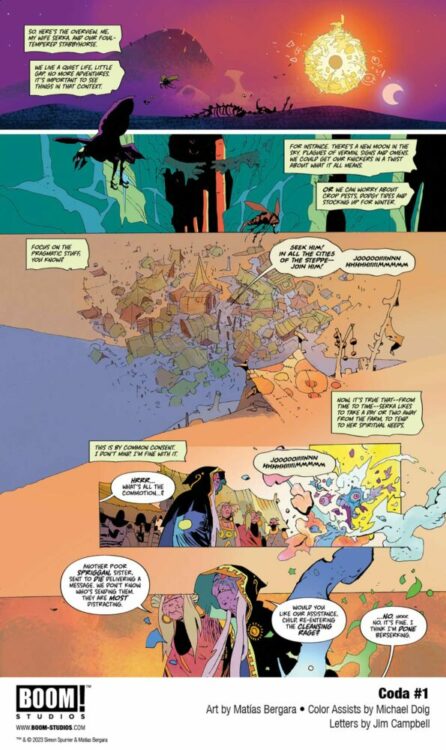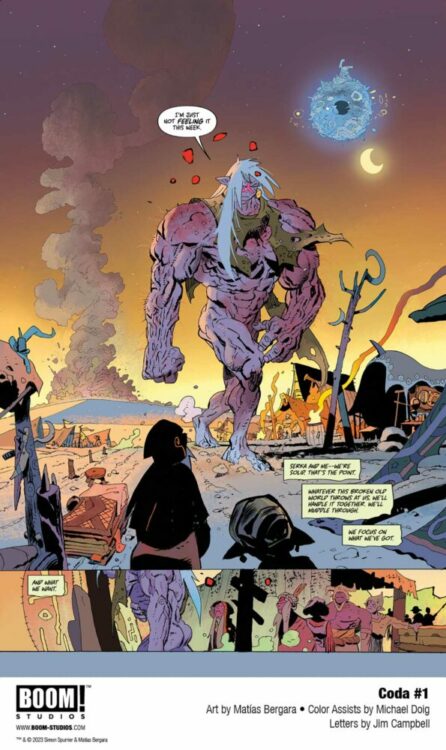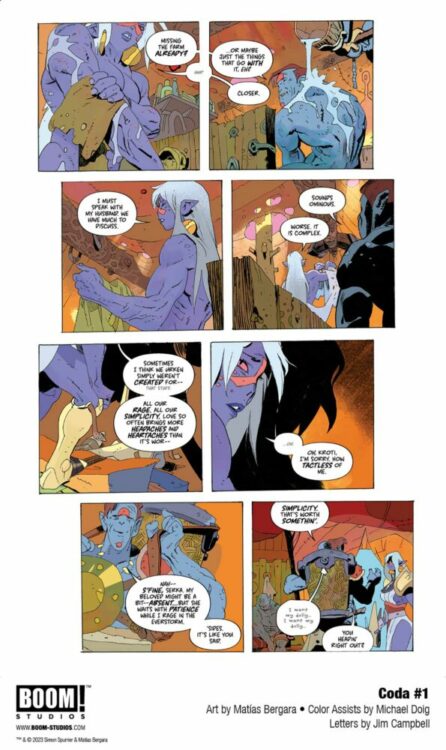From the acclaimed creative duo of writer Si Spurrier and artist Matias Bergara (John Constantine: Hellblazer; Step by Bloody Step) comes the next saga in their brilliant post-apocalyptic fantasy tale with Coda #1. Featuring lettering by Jim Campbell, this first chapter to their follow-up mini-series puts familiar faces in a series of increasingly complex conundrums – from mobs backed by religious propaganda to gnomes with firearms. With a dense, deeply clever script and staggering visual work, this sequel-series is off to a phenomenal start.
“In this brand new adventure in the apocalyptic fantasy world of Coda, the despondent bard Hum finds a slice of tranquility with his wife, the Urken named Serka, in an ever-darkening, magic-less apocalypse – or so it seems. Prophecies of paradise and the return of magic? Hum is skeptical, while Serka faces difficult moral decisions on the road, with winter quickly approaching…”
Writing & Plot
Si Spurrier drops readers new and old head first back into the world he and Bergara created in Coda #1. Taking place some years after the original series ended, Hum and Serka are living their lives keeping to their ways – with Hum preferring a quiet life away from others, Serka needing to take trips as a warrior in service of others. Naturally, things get complicated, and the pair are exposed to new, rising elements in a reality that is still reeling from the events of the last series. Spurrier does a great job setting this issue up for both newcomers and fans of the original series. The events of the last story are referenced from time to time, but there’s never a point where a newcomer may feel lost. Spurrier focuses his efforts on the here and now of this sequel series, and with the problems that have started to crop up. As with most of Spurrier’s work, much of this comic’s reading experience is tied to overhead narration that digs out the thoughts of the main character. The grumpy, sharp delivery in these boxes fits Hum’s personality very well, while also feeling like it’s the writer speaking to the audience. These blurbs do make the read more on the dense side, but they add tremendous personality to the script. Spurrier’s clever humor always lands with a mix of absurdity and the unexpected. Hum and Serka’s two very different experiences each have their own weirdness and increasing complications – complications that closely align with elements of our own world. Spurrier’s sometimes hilarious and sometimes deeply insightful dialogue gives all of his characters distinct personality while adding thematic weight to the story. Overall, this follow-up series is off to a brilliant start in terms of its unique storytelling sensibilities.
Art Direction
Few artists have as unmistakable an approach as Matias Bergara in the pages of Coda #1. His art is always amazing to witness, but what he does in Coda is pure comics magic. Bergara’s character designs for this world are a motley mix of shapes, sizes, and fantastical uniform. Hum’s now-iconic cloak, hat, and staff offset his grizzled appearance. His wife Serka is drawn with a Conan-like frame that can change into a twisted mass of berserker muscle. Every being, from gun-toting gnomes to the simple peasantry, make up an equal part of this menagerie of utterly unique fantasy. Bergara’s sequential direction carries the pacing perfectly, with an ever-shifting approach to panels based on what is happening in the plot. His colors are the stunning exclamation point to the visual experience that will draw readers to the pages with their vivid variety. Every panel is a collage of shades and contrasting tones, perfecting the collage-like numerousness of this world’s cast of beings. The lettering from Jim Campbell is just as clever as the rest of the book’s work. He fades and minimizes his fonts to capture the tone and volume of each character as they speak – especially useful for Hum since he mutters so much. Overall, the visual experience for Coda is a beautiful show of unique comics talent.
Verdict
Coda #1 is a phenomenal start to this sequel mini-series. Si Spurrier’s writing may be a bit dense for some, but its clever humor and poignant messaging make his script a hyper-engaging joy to read. Matias Bergara’s visual direction is singular and stunning, with a creative approach to character design and color art that will pull readers right into this world of strange fantasy. Be sure to grab this opening issue when it hits shelves on September 13th!

